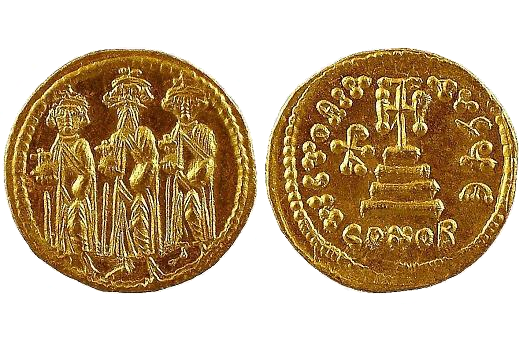
about ancient nomos
Ancient Nomos Art is a museum of galleries exhibiting ancient coins and ancient mint maps. The coin gallery displays the diverse art and history of hand-crafted ancient Greek, Roman, Byzantine, Persian and Medieval coinage. The ancient mints mapping gallery features Greek, Roman, Byzantine, Asia Minor and Medieval mint city regions and territories. Visitor's are welcome to explore, study and enjoy Ancient Nomos Art.

Byzantine, Roman – 639 AD
Flavius Heraclius
From Ancient Galleries

Obverse: Emperor Heraclius flanked by sons Heraclius Constantine and Heraclonas, each facing and crowned holding a globus cruciger, beaded border.
Reverse: Cross potent on four steps with Heraclius mongram in left field.
LEGEND
Obv. Bearded Emperor Heraclius flanked by his sons Heraclius Constantine and Heraclonas facing forward, each crowned, cuirassed and holding a globus cruciger with cross in their upraised right hands. Rev. VICTORIA AVGU, cross potent on four steps, Heraclius monogram in field to left, E to right, CONOB below.
Emperor Heraclius was born 575 AD and officially named Flavius Heraclius Augustus upon succession to the throne. He was Byzantine Emperor from October 5, 610 to February 11, 641. Heraclius came to power following a successful revolt in North Africa against the tyrannical rule of the Emperor Focas. His son Heraclius Constantine was elevated to joint rule in 613 A.D and appears on this coin. When Heraclius took power, the Empire was in need of political and military reform. After gaining power from Focas, he began to rebuild the Roman army. His reforms included the granting lands to individuals in return for hereditary Roman military service. Heraclius reached the height of his power in 630 AD when he marched triumphantly into Jerusalem and restored the True Cross to the Church of the Holy Sepulchre. Unfortunately, this began to facilitate the eventual Arab conquest of Persia and the eastern provinces of the Byzantine Empire. This gold solidus cleverly signals several Byzantine departures from Rome’s influential past. First, the obverse depicts the taller Heraclius centered between his two sons, all in royal dress, capped with a cross, holding globus crucigers, rather than fitted in the usual military attire (see Justinian I). There is also the conspicuous absence of any legend titles, marking a first step toward the obverse featuring total Christian symbolism. Imperial imagery will soon be relegated to the coins reverse. Secondly, the reverse now depicts a large central cross on four steps, rather than the usual winged Victory (see Justinian I). Greek legends now appear rather than the usual Latin letters. This marks Byzantine’s shift in focus to a Greek East and away from the Latin West. However, Rome’s heritage still persists with the reverse legend reading: Victoria Augusta (KRBrown2009). Heraclius died in early 641 AD, succeeded by his son Heraclius Constantine, who died after a reign of only 100 days on the throne.
DOCUMENTATION
Value: Solidus. Metal: AV Gold. Weight: 4.45 grams. Mint: Constantinople. Date: 639 – 641 AD.
Attribution: Dumbarton Oaks, II 43d; Moneta Imperi Byzantini, III 50; Sear, Byzantine Coins 769.
Legend, Documentation and Attribution
